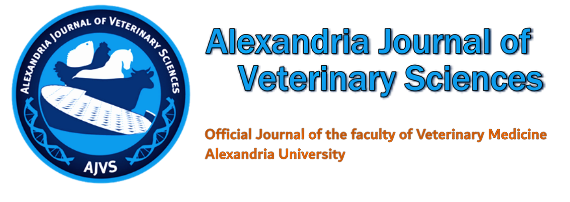
| Original Article Online Published: 31 Mar 2024 | ||||||||||||||||||||||||||||||
AJVS. 2024; 81(0): 64-73 doi: 10.5455/ajvs.191287 Eugenol Improved Antioxidant Status, Proinflammatory and Apoptotic Markers on Rats Exposed to Cardiotoxicity Nesma Soliman, Reham Fahmy, Mohamed El-adl.
| ||||||||||||||||||||||||||||||
| How to Cite this Article |
| Pubmed Style Soliman N, Fahmy R, El-adl M. Eugenol Improved Antioxidant Status, Proinflammatory and Apoptotic Markers on Rats Exposed to Cardiotoxicity. AJVS. 2024; 81(0): 64-73. doi:10.5455/ajvs.191287 Web Style Soliman N, Fahmy R, El-adl M. Eugenol Improved Antioxidant Status, Proinflammatory and Apoptotic Markers on Rats Exposed to Cardiotoxicity. https://www.alexjvs.com/?mno=191287 [Access: May 03, 2025]. doi:10.5455/ajvs.191287 AMA (American Medical Association) Style Soliman N, Fahmy R, El-adl M. Eugenol Improved Antioxidant Status, Proinflammatory and Apoptotic Markers on Rats Exposed to Cardiotoxicity. AJVS. 2024; 81(0): 64-73. doi:10.5455/ajvs.191287 Vancouver/ICMJE Style Soliman N, Fahmy R, El-adl M. Eugenol Improved Antioxidant Status, Proinflammatory and Apoptotic Markers on Rats Exposed to Cardiotoxicity. AJVS. (2024), [cited May 03, 2025]; 81(0): 64-73. doi:10.5455/ajvs.191287 Harvard Style Soliman, N., Fahmy, . R. & El-adl, . M. (2024) Eugenol Improved Antioxidant Status, Proinflammatory and Apoptotic Markers on Rats Exposed to Cardiotoxicity. AJVS, 81 (0), 64-73. doi:10.5455/ajvs.191287 Turabian Style Soliman, Nesma, Reham Fahmy, and Mohamed El-adl. 2024. Eugenol Improved Antioxidant Status, Proinflammatory and Apoptotic Markers on Rats Exposed to Cardiotoxicity. Alexandria Journal of Veterinary Sciences, 81 (0), 64-73. doi:10.5455/ajvs.191287 Chicago Style Soliman, Nesma, Reham Fahmy, and Mohamed El-adl. "Eugenol Improved Antioxidant Status, Proinflammatory and Apoptotic Markers on Rats Exposed to Cardiotoxicity." Alexandria Journal of Veterinary Sciences 81 (2024), 64-73. doi:10.5455/ajvs.191287 MLA (The Modern Language Association) Style Soliman, Nesma, Reham Fahmy, and Mohamed El-adl. "Eugenol Improved Antioxidant Status, Proinflammatory and Apoptotic Markers on Rats Exposed to Cardiotoxicity." Alexandria Journal of Veterinary Sciences 81.0 (2024), 64-73. Print. doi:10.5455/ajvs.191287 APA (American Psychological Association) Style Soliman, N., Fahmy, . R. & El-adl, . M. (2024) Eugenol Improved Antioxidant Status, Proinflammatory and Apoptotic Markers on Rats Exposed to Cardiotoxicity. Alexandria Journal of Veterinary Sciences, 81 (0), 64-73. doi:10.5455/ajvs.191287 |








